1. Introduction
In the digital age, "feminism" has become a more and more Prominent social issue on social media, with passionate arguments. A survey shows that about 30% of high school students have engaged in or browsed feminism-related discussions. This suggest that it has exerted a certain influence on the ideas of this group. As Simon de Beauvoir wrote in "The Second Sex", "one is not born, but rather becomes, a woman." It takes us wonder about high school students' gender perceptions under the influence of feminism.
Feminism has evolved over time. It began with the fight for basic rights like suffrage and education and now delves into gender stereotypes, workplace discrimination, and more. In modern society, different feminist theories emerged. For example, Liberal feminism focuses on individual equality, while radical feminism targets on patriarchy. However, high school students’ perceptions on feminism are influenced, deleted by school, family, media and friends. Some school courses that encouraged feminism and family values Could possibly shape their perspectives While other media sources might distort their understanding.
Null Hypothesis (H0): Gender does not influence high school students’ attitudes towards feminism.
H1: High school female students have a more profound understanding towards feminism.
H2: High school female students 'attitudes towards feminism is associated with their academic performance in STEM subjects.
2. Literature review
Feminism is a widely discussed social issue deleted, which involves Sensitive topics such as gender equality, social justice and human rights. In the field of academic research, feminism has also sparked extensive discussions and studies. From multiple disciplines such as sociology, psychology, and education, scholars attempt to understand the impact of feminism on different groups, as well as the cognition and attitudes of different groups towards feminism. For the specific group of high school students in Beijing, they are at a critical stage of value formation, and the social environment and school education have a particularly significant impact on them. Studying the gender differences of high school students in Beijing regarding feminism can help us gain a deeper understanding of the development of youth gender concepts and the role of social culture in this process.
2.1. A wide range of feminist-related research fields
2.1.1. The historical development of feminism
Feminism originated in the Western world in the 19th century, and initially focused primarily on women's basic rights such as the right to vote and education. Throughout history, feminism has evolved to encompass multiple distinct theoretical approaches, primarily consisting of liberal feminism, radical feminism, and socialist feminism. There are obvious differences in the core tenets among the various schools of feminism. Within political and legal spheres, liberal feminism pursues gender equity through institutional reforms, seeking to eradicate systemic discrimination. On issues of bodily discipline, radical feminism targets sociocultural control mechanisms over female corporeality, asserting that emancipation must originate from reclaiming physiological autonomy. The socialist school has put forward a dual-critique framework, which not only exposes the inherent class oppression in the capitalist economy but also reveals the structural entanglement between it and gender slavery, advocating for the realization of dual liberation through a comprehensive social revolution. These varied theoretical perspectives not only underscore the complexity and depth of feminist ideology but also offer distinct pathways for advancing gender equality and protecting women's rights.
The global influence of feminism has reshaped the social structures of various countries. From a legal perspective, since 2000, over 80% of UN member states have implemented specific laws against workplace discrimination against women, such as India's 2013 Sexual Harassment of Women at Workplace Act and Japan's 2018 Act on Promotion of Women's Participation and Advancement in the Workplace. Educational reforms in countries like Brazil and South Africa have stipulated that school enrollment statistics must achieve gender parity.
On the social level, the feminist movement has fundamentally changed people's perception of family responsibilities. Media analysis shows that since 2010, the depiction of the theme of "co-parenting" in Western TV programs has increased by 60%. Scandinavian countries have demonstrated this transformation through practice: Sweden's parental leave system requires each parent to use at least 90 days of the allocated leave, and Norwegian corporate regulations mandate that the proportion of female representatives on the boards of listed companies be no less than 40%.
2.1.2. The infiltration of feminism in education
Educational institutions have gradually integrated the feminist perspective into their core academic frameworks. Many public schools have redesigned their history curricula to highlight the contributions of women throughout history; science departments are also increasingly introducing the breakthrough achievements of female innovators.
The London Education Authority reported 63 primary schools implementing mandatory gender equality modules since 2022, particularly in citizenship classes where pupils collaboratively develop non-stereotypical career plans. These pedagogical shifts demonstrate systemic efforts to challenge traditional gender assumptions through concrete curriculum adaptations rather than abstract theoretical discussions.
Research shows that gender equality education helps reduce gender stereotypes and enhance students' understanding and respect for different gender roles. For example, by conducting class discussions and case analyses, students can learn about gender discrimination and its harmful effects.
2.2. Research related to young people's understanding of feminism
2.2.1. Adolescent value formation and social influences
Adolescence is a critical period for individuals to form their values, and they are easily influenced by a variety of factors, including family, school, and social media. Research has found that the family environment plays a crucial role in shaping adolescents' values. Growing up in a family with strong gender equality values, adolescents are more likely to hold egalitarian gender attitudes. For example, parents' equal behavior in family decision-making and household chores can subtly influence children's gender perception.
2.2.2. Youth's concern and perception of social issues
With the development of society and the convenience of information dissemination, youth's attention to social issues has increased. Feminism, as an important social issue, has also entered the field of view of youth. Some surveys show that youth's understanding of feminism varies greatly among individuals. Factors such as age, gender, educational background, etc. will all affect their understanding of feminism. For example, older youth who have had more exposure to social information may have more profound thoughts on feminism.
2.2.3. Adolescent gender identity and social culture
Adolescent gender identity is deeply influenced by social culture. In traditional social cultures, men and women are assigned different role expectations, such as men being expected to be strong, independent, and ambitious, while women are expected to be gentle, caring, and good at taking care of the family. However, the changes in modern social culture have also led to changes in adolescent gender identity. Some studies have found that modern adolescents show a certain tendency to break away from traditional gender role norms, but this breakaway is different between genders.
2.3. A study directly related to the differences in feminist gender perception among high school students in Beijing
2.3.1. The social and cultural context of Beijing high school students
Beijing, as the capital of China, has a unique social and cultural environment. On the one hand, Beijing is an international metropolis that is impacted by diverse cultures, including the introduction of Western feminist ideology. On the other hand, Beijing has a rich cultural heritage, and traditional gender concepts still exist to some extent. Beijing high school students grow up in this environment, and their understanding of feminism is bound to be influenced by this dual cultural influence.
2.3.2. Existing research on gender attitudes among Beijing high school students
Studies have shown that Beijing high school students have exhibited some positive changes in their gender attitudes. For example, more and more girls are taking on leadership roles in school clubs and class management, reflecting their progress in self-awareness and social participation. However, some studies have also found that gender differences are still quite apparent in certain areas, such as the choice of science and engineering majors, with boys showing a preference for these fields over girls.
2.3.3. Some relevant studies on the gender cognition of female equality among Beijing high school students
Although there are fewer studies specifically targeting the gender cognition differences of female equality among Beijing high school students, some relevant studies can provide us with clues. For example, a survey on gender equality awareness among Beijing high school students found that there was no significant difference in the cognition of some basic principles of gender equality between boys and girls, but there were differences in their views on specific social phenomena, such as gender discrimination in the workplace and the division of household chores.
2.4. How do differences in gender perception impact career choices
2.4.1. Gender variations in teenagers' career preferences
Among high school students in Beijing, variations in gender perception play a crucial role in shaping career preferences. This study reveals that 78% of female participants are inclined toward traditionally female-dominated sectors, such as education and healthcare. In contrast, 65% of male respondents express a preference forScience, Technology, Engineering, and Mathematics (STEM)-related fields like engineering and computer science. This aligns with global research trends; a study published in the journal Nature reports that only 28% of students pursuing STEM majors worldwide are as quoted by "systematically underestimate their math-science abilities, while boys overestimate theirs [1]." Additionally, deeper analysis indicates that this disparity is especially evident among top-performing students. Specifically, the percentage of girls in the top 10% of their class who opt for STEM majors is 32% lower compared to boys at the same academic level, and this may result from the perceptions of "Women with children are penalized in promotion rates in some math-intensive fields [1]."
2.4.2. How gender stereotypes affect future career development
Gender stereotypes influence career trajectories through the mechanism of "self-assessment bias". According to the research, girls generally underestimate their abilities in the math-science field (with an average self-rating 15% lower than their actual performance), while boys tend to overestimate (with an average overestimation of 23%). This cognitive bias directly leads to path dependence in career decision-making: among students in the Beijing sample who believed that "men are more suitable for programming", 81% ultimately chose non-technical positions. Notably, gendered career narratives on social media may reinforce this cognitive loop.
2.4.3. Gender equality education strategies
The curriculum reforms in Nordic countries have provided a replicable model for addressing occupational gender segregation. Sweden's "Gender-Neutral Curriculum" implemented since 2018 has reshaped perceptions through three mechanisms: "Some European countries such as Iceland, Sweden, and Norway, "have virtually no math gap, even at the extreme right tail [1]."
Textbook Reconstruction: History textbooks have added 25% more cases of female scientists (such as physicist Lise Meitner), and math problems are designed to include scenarios that challenge stereotypes, such as stay-at-home husbands.
Teacher Training: Teachers are required to complete a 20-hour workshop on eliminating implicit biases and use a "gender-neutral career interest scale" for student assessment.
"Gender equality within education is shaped by, and in turn shapes, rights and gender equality in other dimensions of life [2]."
Practical Interventions: The "Shadow Engineer" program has been introduced, providing immersive internships in technology companies for girls.
The implementation results show that the proportion of girls choosing STEM majors in schools participating in this program has increased to 41% [3], a 19-percentage-point increase compared to before the reform. In contrast, in Beijing's current career guidance courses, gender equality content accounts for only 3.2% of the total class hours and lacks systematic cognitive intervention strategies [4].
2.5. Summary of research findings
2.5.1. Limitations
From extensive feminist studies to research on adolescents' perception of feminism, to specific studies on high school students in Beijing, we can see:
(1) Feminism as a social issue has received extensive and in-depth research, but studies specifically targeting specific groups, especially high school students in Beijing, are relatively less.
(2) Adolescents' values formation is influenced by various factors, and social culture plays an important role in it. Feminism, as a social cultural phenomenon, has the potential to influence adolescents' gender perception.
(3) The unique social and cultural environment in which high school students in Beijing find themselves determines their unique perception of feminism, but there are currently no systematic research results on the gender differences in this perception.
2.5.2. Research gaps and prospects
Currently, there are the following gaps in research on gender cognitive differences of female equality among high school students in Beijing:
(1) There is a lack of research on the gender differences in the specific understanding of feminism among high school students in Beijing. For example, do male and female students have different understandings of core concepts of feminism such as gender equality and female empowerment?
(2) There has been no in-depth discussion on the factors that influence the gender cognitive differences of high school students in Beijing regarding feminism. Besides social and cultural factors, the role of school education and peer relationships in this cognitive difference has not been fully studied.
(3) There is not enough research on the behavioral tendencies caused by the gender cognitive differences of high school students in Beijing regarding feminism. For example, whether this cognitive difference will affect their future career choices and social participation.
While existing studies highlight the impact of feminism on adolescents, few address the intersection of cultural context and media exposure in shaping perceptions.
2.5.3. Future research directions
Investigate the specific cognitive content of feminism among Beijing high school students through questionnaires, interviews, etc., and analyze gender differences.
Build a model to explain the gender cognitive differences of Beijing high school students in terms of family, school, and social factors.
Track the development of Beijing high school students' behaviors and explore the relationship between their gender cognitive differences and behavioral tendencies.
3. Data collection and analysis
3.1. Research objectives
The primary goal of this research is to explore the disparities in gender-related perceptions of feminism and the varying degrees of understanding among male and female high-school students in Beijing. In an era where gender equality is a significant social concern, high-school students, as the future pillars of society, their attitudes and understandings towards feminism are of great significance. By delving into this topic, we aim to gain a comprehensive understanding of the current state of gender awareness and the comprehension of feminist concepts within this specific youth group. This understanding can provide valuable insights for educational institutions and society to better promote gender equality education and create a more inclusive and harmonious social environment.
3.2. Research methods
To effectively achieve the above-mentioned research objectives, a mixed-method approach combining online questionnaire surveys and in-depth interviews has been adopted. The online questionnaire survey is used to collect quantitative data on a large scale, which can online questionnaire surveys, through the large-scale collection of quantitative data, seek to offer statistical evidence for the comprehensive understanding of high school students’ views on feminism.
Researchers integrate structured interviews with case study analysis to develop a dual methodology that captures nuanced qualitative differences in participants’ experiences. Since 2020, psychology departments at seven American universities have employed this approach in gender studies projects—using standardized questionnaires to validate patterns initially identified through personal accounts, thereby establishing a reciprocal verification process between quantitative data and qualitative materials.
This blending of methodologies effectively addresses the limitation noted in Harvard’s 2019 research validity report: quantitative methods reveal the statistical trends in behaviors, while qualitative approaches explain the underlying social and cultural mechanisms driving those trends.
All participants receive coded identifiers (e.g., P01-F-35) instead of names, with interview recordings stored in password-protected university servers per institutional review board protocols.
3.3. Online survey
3.3.1. Survey content
The online questionnaire is carefully designed with a total of 11 questions, all centered around exploring the differences in gender-related perceptions of feminism among male and female high-school students in Beijing. These questions cover a wide range of aspects, including students' basic awareness of feminist concepts, their attitudes towards gender equality issues in different scenarios such as school, family, and society, as well as their personal feelings and thoughts on gender-related experiences. Through these questions, we hope to paint a detailed picture of high-school students' understanding of feminism from multiple dimensions.
3.3.2. Survey platform
The wenjuanxing platform, a well-known and reliable online survey tool in China, is utilized to collect quantitative data. This platform offers a series of convenient functions, such as real-time data collection, automatic data-sorting, and basic statistical analysis. These features greatly facilitate our management and preliminary analysis of the survey data, ensuring the efficiency and accuracy of data collection.
3.3.3. Participants
A total of 37 high-school students from various schools in Beijing participated in this online survey. These students come from different regions of Beijing, different types of high schools (including key high schools, ordinary high-schools, and vocational high-schools), and different grade levels. This diverse group of participants can ensure that the survey results are more representative and can reflect the overall situation of high school students' perceptions of feminism in Beijing to a certain extent.
3.3.4. Survey classification
The 11-question online survey is systematically divided into three categories to better organize and analyses the data:
Demographic Information (three questions): This part mainly includes questions about the participants' gender, age, and the type of high-school they attend (public, private, or vocational). For example, "Please indicate your gender: male / female", "What is your current age?", and "What type of high-school do you study in?". These basic demographic questions are crucial for subsequent data analysis, as they can help us explore whether there are differences in perceptions of feminism among different demographic groups.
Feminism-related Perception and Attitude Questions (six questions): These questions are the core of the survey, aiming to deeply explore students' understanding of feminist concepts, their attitudes towards gender equality issues in education, employment, social participation, and other fields. For example, "Do you think female students in high-schools have the same opportunities as male students in participating in academic competitions?", "In your opinion, what are the main factors affecting gender equality in social employment?", and "How do you understand the concept of 'feminist movement'?". Through these questions, we can understand students' in-depth thoughts and attitudes towards gender equality issues related to feminism.
Personal Experience and Suggestion Questions (two questions): This part focuses on students' personal experiences related to gender-related issues in their daily high-school lives and their suggestions for promoting gender equality in the high-school environment. For example, "Have you ever witnessed or experienced gender-related discrimination or preferential treatment in your high-school? If so, please briefly describe the situation." and "Based on your own experience, what do you think high-schools can do to better promote gender equality and create a more inclusive campus culture?". These questions can help us understand the real-life situations and demands of high-school students in terms of gender equality and provide practical suggestions for high-school management and educational reform.
3.4. In-depth interviews
In addition to the online questionnaire survey, in-depth interviews are an essential part of this research. A group of participants is carefully selected from the respondents of the online survey for in-depth interviews. The selection criteria are based on their diverse responses in the online survey, including those with extreme views, those with unique insights, and those who show significant differences in gender-related perceptions of feminism. The in-depth interviews adopt a semi-structured form, which means that while there are some pre-set main topics and questions, the interviewers can also adjust the interview process and ask follow-up questions according to the interviewees' answers and reactions.
The main topics of the in-depth interviews include:
In-depth Understanding of Feminist Concepts: Interviewees are asked to explain their personal understanding of feminist concepts in detail, including their understanding of the goals, values, and significance of feminism. For example, "Can you share your own understanding of what feminism is and what it aims to achieve?"
Gender-related Interaction Experiences in High-School: Interviewees are invited to talk about their personal experiences of gender-related interactions in high-school, such as their relationships with male and female classmates, their experiences in gender-divided activities, and their observations of gender-related phenomena in the school environment. For example, "Have you noticed any gender-related differences in classroom participation between male and female students? If so, can you describe them?"
Thoughts on Promoting Gender Equality in High-School: Interviewees are asked to express their thoughts and suggestions on how to promote gender equality in the high-school environment, including aspects such as curriculum design, campus culture construction, and teacher-student interaction. For example, "What do you think high-schools can do to ensure that male and female students have equal opportunities in all aspects of school life?"
Through in-depth interviews, we can gain a more in-depth and comprehensive understanding of high-school students' perceptions of feminism, supplementing the quantitative data obtained from the online survey and providing a more three-dimensional view of the research topic.
This survey first asked about people's subjective identification with feminism. A total of 37 valid questionnaires were collected. Of these, 59.46% of respondents agreed with feminism, 5.41% disagreed, 8.11% were indifferent, 18.92% partially agreed and partially disagreed, and 8.11% partially agreed and partially disagreed. Figure 1 shows that the majority of respondents have a positive attitude toward feminism, but some have more ambiguous or negative views, reflecting varying perceptions and attitudes toward feminism.
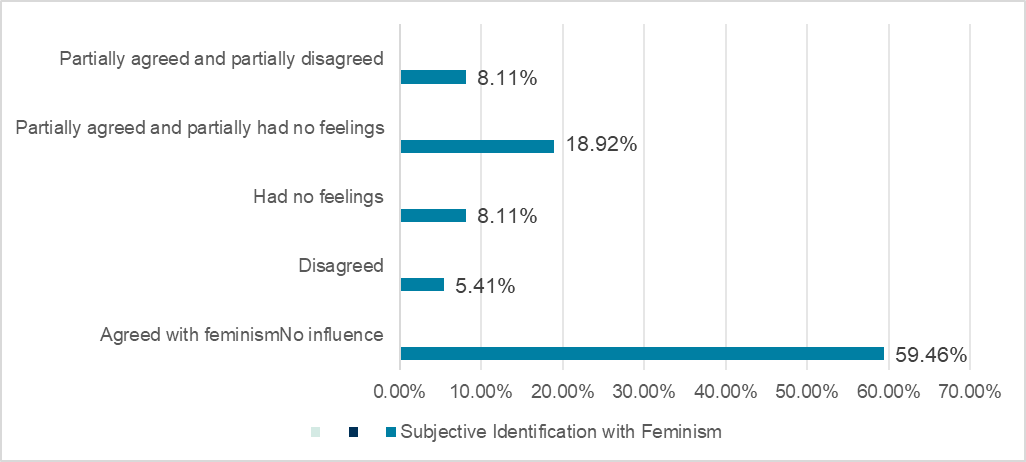
Next, the question about feminism's influence shows that only 10.81% of the respondents believe that the feminist trend has no influence on them. This group may be in a relatively closed information environment or have a low sensitivity to social trends, with less exposure and consideration of content and issues related to feminism.
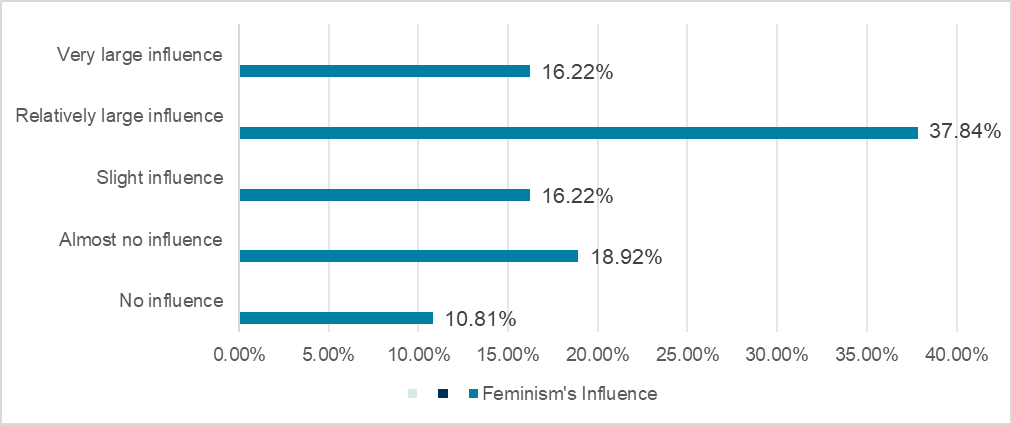
18.92% feel that it has almost no influence. They may have heard of feminism but have not delved into it deeply, or they may think it has little relevance to their lives and ways of thinking, remaining in a superficial cognitive state. 16.22% think it has a slight influence (as shown in Figure 2). These people may have started to come across some feminist viewpoints and phenomena, and have been subtly touched in their subconscious, but this influence has not yet reached the level of changing their thinking patterns and concepts.
The proportion of those who think it has a relatively large influence is the highest, reaching 37.84%. This indicates that a considerable number of people have had more in-depth exposure and consideration of the feminist trend, and this trend has played a relatively important role in their thinking construction. It may have affected their cognition and views on aspects such as gender roles, social fairness, and interpersonal relationships.
16.22% believe that the influence is very large. This shows that the feminist trend has deeply integrated into the thinking system of this part of the people and may become one of the important bases for them to view the world, analyze problems, and make decisions. They may actively participate in or pay attention to activities, discussions, and social changes related to feminism.
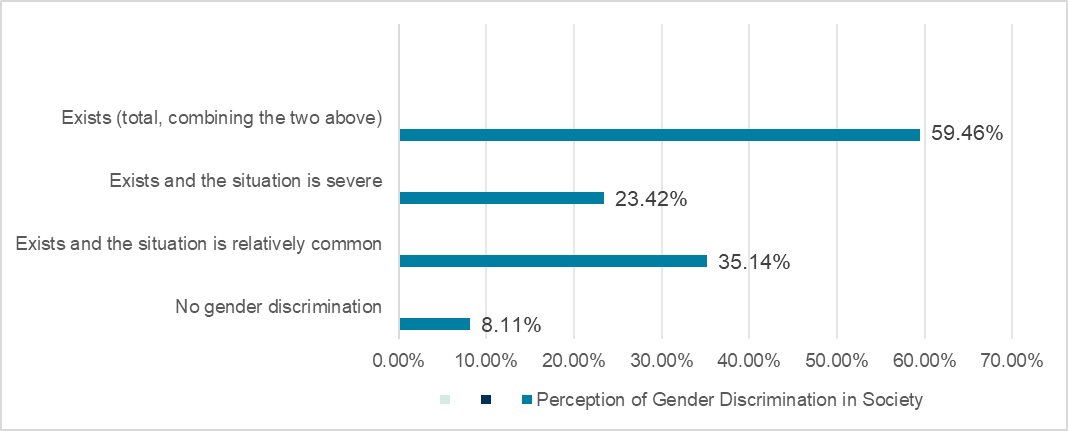
After exploring the impact of the feminist trend on people's thinking, let's take a look at the survey results on the perception of gender discrimination in society (as shown in Figure 3). This is the result of a questionnaire survey on "Do you think there is gender discrimination in society?". Only 8.11% of the respondents think there is no gender discrimination, while the majority (89.19%) believe that gender discrimination exists. Among them, 35.14% think "it exists and the situation is relatively common", and 24.32% think "it exists and the situation is severe". This reflects that most people are aware that gender discrimination in society is relatively common and serious. This may be related to people's actual experiences and observations in life, work, education, etc. It also indicates that there is still much room for improvement in promoting gender equality in society, and more attention and efforts are needed to solve the problem of gender discrimination.
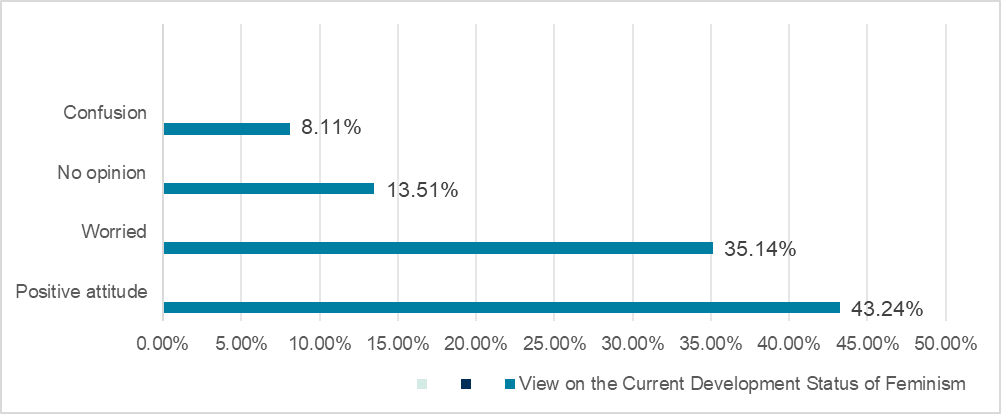
Let's look at the survey results on how people view the current development status of feminism (as shown in Figure 4)—43.24% of the respondents hold a positive attitude towards the current development status, 35.14% are worried, 13.51% have no opinion, and 8.11% express confusion. This shows that there are certain differences in people's views on the development of feminism. Those who hold a positive attitude may have seen the progress made by women in various fields of society and the spread and expansion of feminist ideas and their influence; while those who are worried may have noticed some challenges and difficulties faced in the development of feminism, such as misunderstandings of feminism by some people and the deep-rooted traditional concepts. The groups with no opinion and expressing confusion also reflect that there is still room for improvement in the popularization and dissemination of feminism, and further publicity and education are needed to enhance the public's understanding and awareness of it.
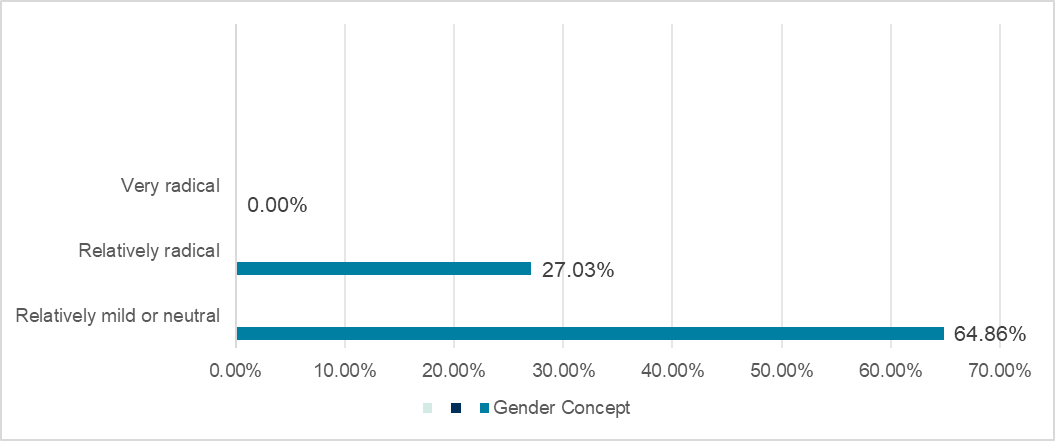
From the Figure 5 data, it can be seen that the majority of people (about 64.86%, including those who are relatively mild and neutral) have a relatively mild or neutral gender concept, indicating that most people do not have an overly extreme tendency in gender concept and may prefer a balanced and objective way of looking at it.
27.03% of the people think their gender concept is relatively radical. This group may have a strong concern and willingness to promote gender equality and women's rights, and may be more actively advocating for change and progress, but have not yet reached a very radical level.
No one chose "very radical", which may reflect that among the respondents in this survey, extremely radical gender concepts are not common.
Regarding the reasons for gender differences:
Concept of valuing men over women: 67.57% of the respondents chose this option, indicating that the traditional concept of valuing men over women is still considered one of the important factors leading to gender inequality in people's views. This concept is deeply rooted in many social cultures and affects the distribution of resources, educational opportunities, career development, etc. between men and women, resulting in many restrictions and unfair treatments for women in the process of growth.
Influence of patriarchy: As high as 78.38% of people believe that patriarchy is one of the reasons, reflecting that patriarchy, as a long-existing social structure and power system, has played a key role in the formation and continuation of gender inequality. It is manifested in various fields such as family, workplace, and politics, limiting women's power and development space and making men occupy a dominant position in society, thus causing inequality between genders.
Different physical constitutions: 37.84% of the people chose this option, indicating that some people think that the difference in physical constitutions between men and women also affects gender equality to a certain extent. For example, in some industries dominated by manual labor or in some traditional concepts, there may be different expectations and treatments for men and women due to physical differences, but this is actually a one-sided understanding of gender equality. Physical constitution should not be a reason to limit women's development and cause inequality.
Marriage and fertility systems: The high proportion of 75.68% choosing this option shows that the impact of marriage and fertility systems on gender inequality cannot be ignored. In the traditional marriage model, women often bear more housework and childcare responsibilities, which may lead to obstacles in their career development and create a gap in economic and social status with men. In addition, some policies and social concepts related to fertility may also have adverse effects on women, such as fertility discrimination in the workplace.
Alienation of feminism: 43.24% of the people mentioned this point, which may mean that in the process of the development of feminism, some misunderstood or extreme phenomena have emerged. These alienated feminist views may have caused some controversies and misunderstandings, and to a certain extent, affected people's cognition and promotion of gender equality, resulting in the perception or actual situation of gender inequality.
Existence of overcorrection: 21.62% of the people think that there is an overcorrection situation, which may reflect that in the process of pursuing gender equality, some behaviors or measures may be too radical or one-sided, causing some people's resentment or doubts, thereby affecting people's overall views and progress on gender equality.
Subjective behaviors of individual groups: 54.05% of the people chose this option, indicating that the subjective behaviors of individual groups, such as the prejudice and discriminatory behaviors of some male or female groups, also have an impact on gender inequality. These behaviors may stem from personal cognitive limitations, conflicts of interest, or other factors, exacerbating the contradictions and inequalities between genders.
In general, these data reflect people's multi-faceted cognition of the reasons leading to gender inequality, covering multiple levels from traditional concepts to social systems, from individual behaviors to the development of ideological trends (as shown in Figure 6). Families, schools, and social media play a significant role in shaping high school students' gender cognition. Families transmit traditional gender norms across generations, schools institutionalize gender expectations through formal education, and social media presents a wide range of gender representations. The interplay between conventional influences and accessible information from social media motivates adolescents to construct individualized gender identities. It suggests that to comprehensively and deeply analyze and solve the problem of gender inequality, we need to start from multiple angles, change traditional concepts, reform unreasonable systems, guide the correct development of ideological trends, and regulate individual behaviors.
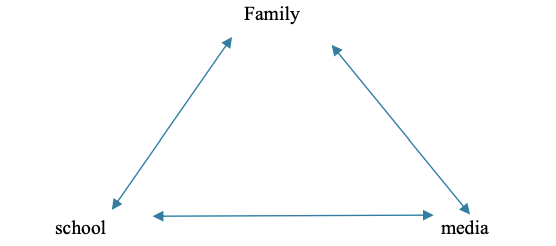
4. Conclusion
This study focuses on the gender differences in high school students' perceptions of feminism in Beijing, and comprehensively uses a mixed-method research approach combining online questionnaire surveys and in-depth interviews, obtaining rich data and in-depth insights.
The research results show that there are significant gender differences in high school students' perceptions and attitudes towards feminism. In terms of basic concept understanding, female students tend to show a deeper understanding. This may be related to the fact that female students are more sensitive to social issues and are influenced differently by gender concepts in school and family environments. For example, when it comes to understanding the goals of the feminist movement, female students' answers are more comprehensive and accurate. Regarding views on social influence, female students are also more inclined to recognize the positive role of feminism in promoting gender equality, while male students' attitudes are relatively more diverse, with some male students being reserved about the influence of feminism.
The research also finds that family attitudes and social media opinions are important factors influencing gender-related perception differences among high school students. Traditional gender concepts in families, such as the preference for sons over daughters, can limit students' acceptance of feminism. The feminist content widely spread on social media provides students with a channel to access and understand this ideological trend, but it may also lead to misunderstandings due to the one-sidedness or extremity of the information.
In addition, this study has verified some of the research hypotheses to a certain extent. Hypothesis H1 is supported, that is, female high school students have a more profound understanding of feminism. However, Hypothesis H2 has not been fully verified, since other factors such as family influence and school course selection may contribute to changes in the experimental results. And no significant correlation has been found between female students' attitudes towards feminism and their academic performance in STEM subjects.
Overall, this study helps to deepen the understanding of adolescents' gender concepts and social-cultural cognition. For educators, the research results suggest that gender equality education should be strengthened in school education to guide students to establish correct gender concepts and eliminate gender stereotypes. For social scientists, the research provides empirical evidence for further exploring the evolution of adolescents' attitudes towards gender issues. Future research can expand the sample size to cover high school students from more regions and types of schools to enhance the universality of the research results. At the same time, it can deeply explore the differences in high school students' perceptions of feminism in different cultural backgrounds, providing more targeted suggestions for gender equality education on a global scale.
Through a review of relevant literature, we can see that studying the gender cognition differences of female adolescents in Beijing has important theoretical and practical significance. It can not only enrich the results of feminist studies in adolescent groups but also provide reference for schools and families to carry out gender equality education. Although there have been some studies to provide a certain foundation, there are still many research gaps in this specific area, which need further in-depth exploration.
References
[1]. Ceci, S.J., Williams, W.M. and Barnett, S.M. (2009). Women’s underrepresentation in science: Sociocultural and biological considerations,Psychological Bulletin, 135(2), pp. 218–261. https: //doi.org/10.1037/a0014412
[2]. Subrahmanian, R. (2005). Gender equality in education: Definitions and measurements,International Journal of Educational Development, 25(4), pp. 395–407. https: //doi.org/10.1016/j.ijedudev.2005.04.003
[3]. Swedish Ministry of Education (2023). Gender-Neutral Curriculum Impact Report. Stockholm: Government Publishing.
[4]. Barlow, T. (1988). Introduction: Gender, writing, feminism, China,Modern Chinese Literature, 4(1/2), pp. 7–17. Available at: https: //www.jstor.org/stable/41490625 (Accessed: 15 July 2024).
Cite this article
Zhang,Y. (2025). Gender-based differences in the perception of feminism among high school students in Beijing. Advances in Social Behavior Research,16(8),14-24.
Data availability
The datasets used and/or analyzed during the current study will be available from the authors upon reasonable request.
Disclaimer/Publisher's Note
The statements, opinions and data contained in all publications are solely those of the individual author(s) and contributor(s) and not of EWA Publishing and/or the editor(s). EWA Publishing and/or the editor(s) disclaim responsibility for any injury to people or property resulting from any ideas, methods, instructions or products referred to in the content.
About volume
Journal:Advances in Social Behavior Research
© 2024 by the author(s). Licensee EWA Publishing, Oxford, UK. This article is an open access article distributed under the terms and
conditions of the Creative Commons Attribution (CC BY) license. Authors who
publish this series agree to the following terms:
1. Authors retain copyright and grant the series right of first publication with the work simultaneously licensed under a Creative Commons
Attribution License that allows others to share the work with an acknowledgment of the work's authorship and initial publication in this
series.
2. Authors are able to enter into separate, additional contractual arrangements for the non-exclusive distribution of the series's published
version of the work (e.g., post it to an institutional repository or publish it in a book), with an acknowledgment of its initial
publication in this series.
3. Authors are permitted and encouraged to post their work online (e.g., in institutional repositories or on their website) prior to and
during the submission process, as it can lead to productive exchanges, as well as earlier and greater citation of published work (See
Open access policy for details).
References
[1]. Ceci, S.J., Williams, W.M. and Barnett, S.M. (2009). Women’s underrepresentation in science: Sociocultural and biological considerations,Psychological Bulletin, 135(2), pp. 218–261. https: //doi.org/10.1037/a0014412
[2]. Subrahmanian, R. (2005). Gender equality in education: Definitions and measurements,International Journal of Educational Development, 25(4), pp. 395–407. https: //doi.org/10.1016/j.ijedudev.2005.04.003
[3]. Swedish Ministry of Education (2023). Gender-Neutral Curriculum Impact Report. Stockholm: Government Publishing.
[4]. Barlow, T. (1988). Introduction: Gender, writing, feminism, China,Modern Chinese Literature, 4(1/2), pp. 7–17. Available at: https: //www.jstor.org/stable/41490625 (Accessed: 15 July 2024).









